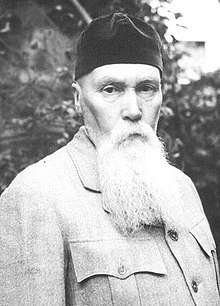You can help expand this article with text translated from the corresponding article in Russian. (October 2023) Click [show] for important translation instructions.
|
This article needs additional citations for verification. (October 2023) |
Nicholas Roerich | |
|---|---|
| Николай Рерих | |
 Roerich c. 1940–1947 | |
| Born | October 9, 1874 |
| Died | December 13, 1947 (aged 73) |
| Nationality | Russian |
| Occupation(s) | painter, archaeologist, costume and set designer for ballets, operas, and dramas |
| Spouse | Helena Roerich |
| Children | George de Roerich, Svetoslav Roerich |
| Signature | |
 | |
Nikolai Konstantinovich Rerikh[a] (Russian: Николай Константинович Рерих), better known as Nicholas Roerich (/ˈrɛrɪk/; October 9, 1874 – December 13, 1947), was a Russian painter, writer, archaeologist, theosophist, philosopher, and public figure. In his youth he was influenced by Russian Symbolism, a movement in Russian society centered on the spiritual. He was interested in hypnosis and other spiritual practices and his paintings are said to have hypnotic expression.[1][2]
Born in Saint Petersburg, to a well-to-do Baltic German father and to a Russian mother,[3] Roerich lived in various places in the world until his death in Naggar, India.[4] Trained as an artist and a lawyer, his main interests were literature, philosophy, archaeology, and especially art. Roerich was a dedicated activist for the cause of preserving art and architecture during times of war. He was nominated several times to the longlist for the Nobel Peace Prize.[5] The so-called Roerich Pact (for the protection of cultural objects) was signed into law by the United States and most other nations of the Pan-American Union in April 1935.
Cite error: There are <ref group=lower-alpha> tags or {{efn}} templates on this page, but the references will not show without a {{reflist|group=lower-alpha}} template or {{notelist}} template (see the help page).
- ^ Nicholas Roerich: In Search of Shambala by Victoria Klimentieva, стр. 31
- ^ Nicholas Roerich Museum Archived October 6, 2014, at the Wayback Machine
- ^ Andrei Znamenski, Red Shambhala: Magic, Prophecy, and Geopolitics in the Heart of Asia, Quest Books (2011), p. 157
- ^ "Nicholas Roerich - Russian set designer". Retrieved June 14, 2016.
- ^ Nobel Prize Nomination Database